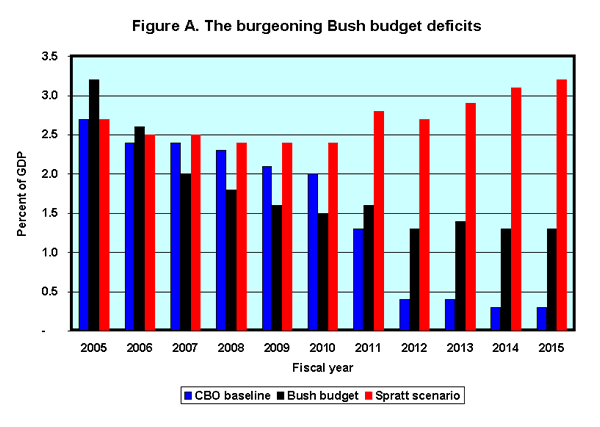See Snapshots Archive.
Snapshot for September 21, 2005.
Red ink rising
A new Congressional Budget Office analysis offers a clearer picture of the federal budget challenges ahead. Under its plausible assumptions, current Bush administration policies will likely produce high and persistent deficits, a scenario that is quite different from both the baseline projections reported by the Congressional Budget Office and the administration’s own budget projections. The baseline figures are prepared according to procedures set by law.
The problem is that in recent years legislation has been deliberately written to defeat the purpose of the projections by stipulating decreases in spending and increases in taxes that are unlikely to occur. Bush budget projections fall prey to the same problem. In addition, the Bush numbers do not include certain of the administration’s commitments, such as the costs of switching part of Social Security to private accounts. Hence these budget estimates understate the cost of implementing the president’s policy goals. The new estimate, prepared by the CBO at the request of ranking minority member of the House Budget Committee John M. Spratt Jr. (D-NC), shows a far clearer picture that includes the costs omitted from the other two projections.
Spratt requested estimates under the following assumptions:
a) the Bush tax cuts are made permanent (as the administration has committed to do);
b) the Alternative Minimum Tax (AMT) is not allowed to continue to increase automatically because its standard deduction is not indexed to inflation (no politician has proposed a way to fix the AMT);
c) the president’s plan for privatizing Social Security is enacted;
d) the president’s spending proposals are enacted and extended through FY2015; and
e) spending in Iraq and Afghanistan decreases gradually.
The Spratt numbers do not include any spending related to Hurricane Katrina, so for that reason, they understate likely deficits to some extent.
The results as they appear Figure A are expressed as a share of the gross domestic product. The blue bars are the official, misleading CBO baseline. The black are the CBO estimates of the Bush budget for FY2006 released in March 2005, and the red bars are the CBO estimates under Spratt’s assumptions.

The CBO’s estimates of the Bush budget are not far from a reasonable deficit path, although the administration’s underlying commitments to regressive tax cuts and misplaced spending priorities remain vulnerable to criticism. President Bush’s numbers are also incomplete, since they don’t include the significant increase in borrowing envisioned under Social Security privatization, the likely cost of AMT reduction, and future defense spending in Iraq and Afghanistan.
Under the more realistic Spratt scenario, the ratio of debt to GDP rises to 46.5% by 2015, from the current level of 37.7%. If foreign investors and governments balk at continuing to lend as much in the future as at present, the economy will face major challenges for which Bush policies leave the nation completely unprepared.
This week’s Snapshot was written by EPI economist Max B. Sawicky.
